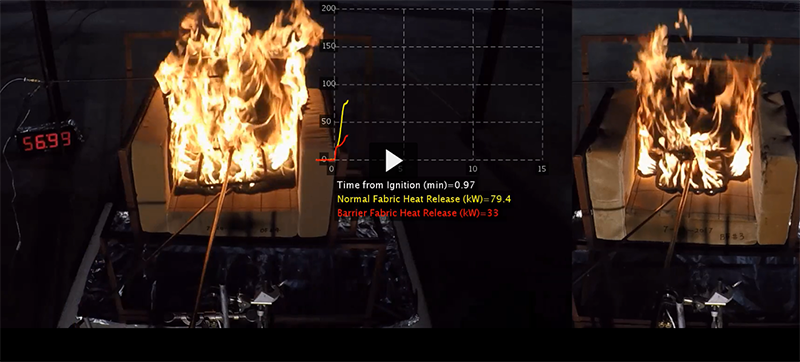A new research roadmap by the National Institute of Standards and Technology (NIST) has developed guidelines for eliminating flammable materials and providing a better strategy to reduce fire-resulted deaths and injuries.
These science-based approaches include using lightweight automobile composites and cross-laminated timbers that can be applied to dangerous fire hazards such as upholstered furniture.

The effect of a NIST-developed back-coating technology for fabrics on the heat release rate of upholstered furniture. Credit: NIST
“Our hope is that this roadmap will help the global fire community develop research strategies and implementation plans for addressing fire and materials problems, now and in the future,” said NIST materials research engineer Rick Davis, according to NIST News. “The roadmap identifies and describes the major challenges associated with these problems and then details potential solutions so that users such as designers and manufacturers can continue to create safer materials that still yield quality products with high consumer satisfaction and market profitability.”
When constructing this roadmap, researchers focused their discussion on four areas of fire hazard concerns:
- Innovative construction materials: using cross-laminated wood for tall buildings
- Advanced polymers and composites: such as polyester fabrics used in furniture and lightweight composites in automobile bodies
- Next-generation fire retardants: using fire retardants that can suppress combustion without being hazardous to one’s health
- Transportation and infrastructure vulnerabilities: such as train fire risks
They also discussed the emerging concern of using lithium-ion batteries and its flammability concerns. They agreed to focus on an approach that would negate multiple hazards, and had a wide range of material and applications. This included understanding how the use of a product affects fire resistance over time, engineering technologies that are compliant with flammability regulations, and developing physical testing methods and computer modeling systems that predict a material’s behavior to fire.
The experts defined the five most critical fire hazards to apply these approaches:
- Residential upholstered furniture
- Residential buildings in Wildland Urban Interface (WUI) communities
- Timber used in multistory buildings
- Passenger railway cars
- Insulation applied to the exterior of multistory buildings
“It’s our hope that the research resulting from the roadmap will lead to science-based quality control measures, testing procedures and performance standards for materials flammability, which in turn, should reduce the costs of making products, simplify regulatory compliance for manufacturers, and provide consumers with more fire-safe product choices,” Davis said.




